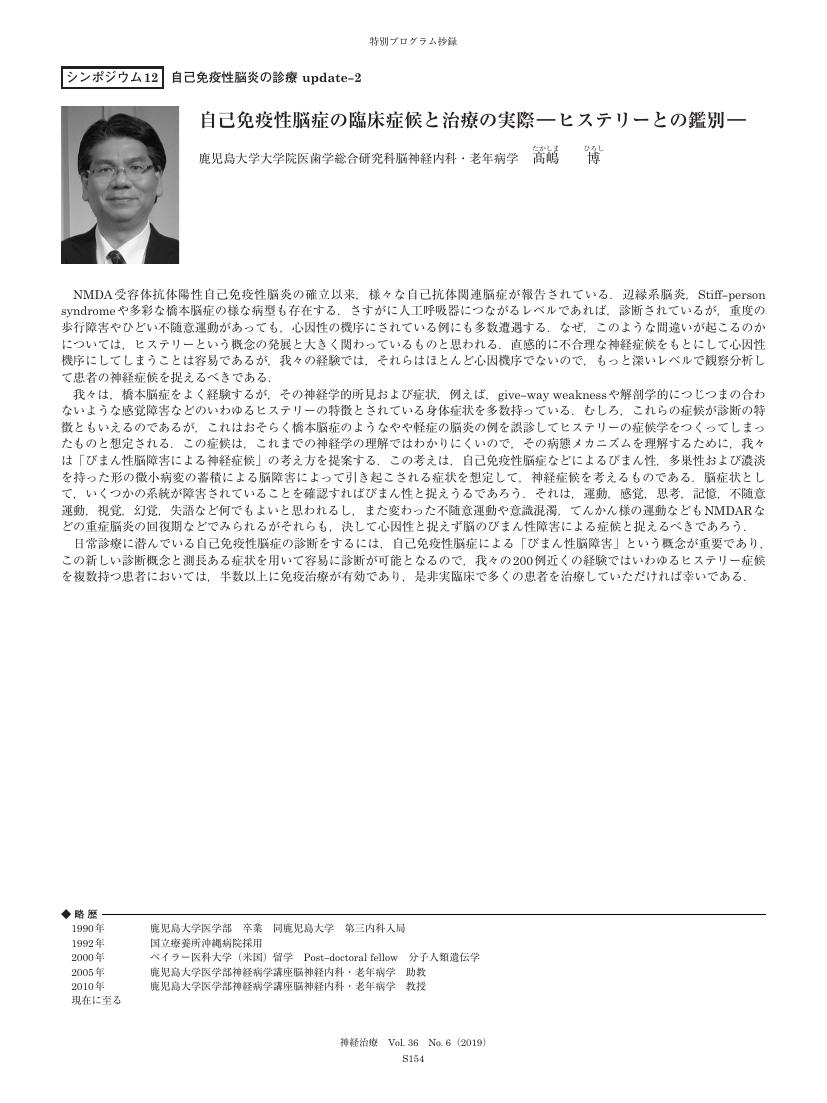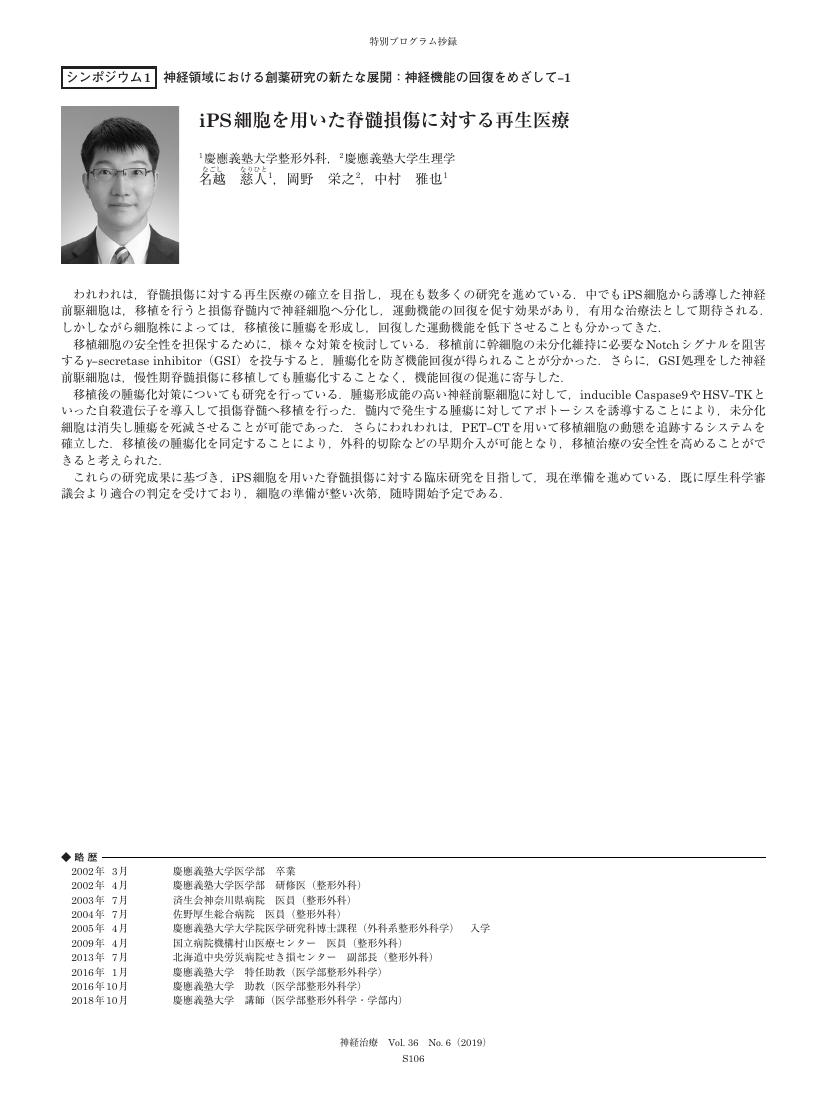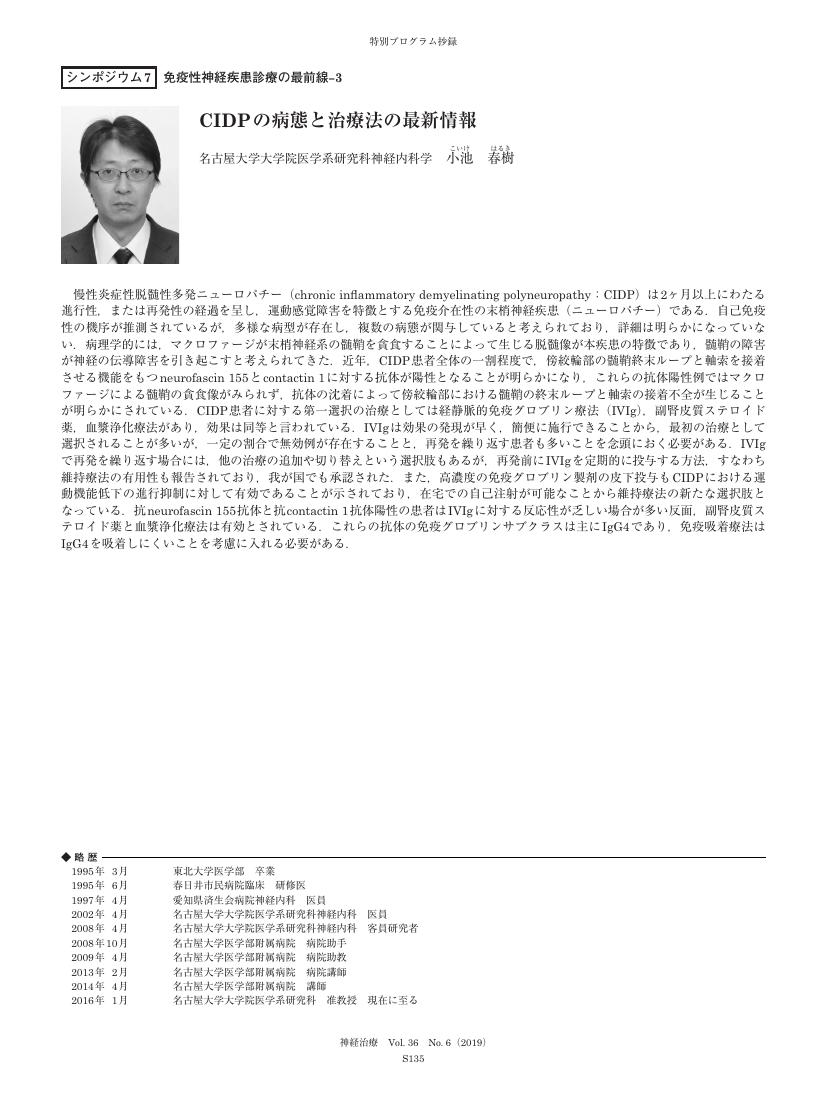1 0 0 0 OA 炎症性筋疾患の自己抗体 Update
- 著者
- 鈴木 重明
- 出版者
- 日本神経治療学会
- 雑誌
- 神経治療学 (ISSN:09168443)
- 巻号頁・発行日
- vol.35, no.4, pp.396-400, 2018 (Released:2019-04-22)
- 参考文献数
- 15
Inflammatory myopathies are a heterogeneous group of immune–mediated diseases that involve skeletal muscle as well as many other organs. The classification of inflammatory myopathies has been based on clinical diagnoses, pathological diagnoses, and autoantibodies, independently. The clinical phenotypes of inflammatory myopathies are characterized by various autoantibodies that are originally detected by RNA or protein immunoprecipitation. However, since the correlation between histological features and autoantibodies had not been fully elucidated, we created the “Integrated Diagnosis Project for Inflammatory Myopathies” in October 2010. Based on our work and previous studies, the three major subsets of inflammatory myopathies defined by autoantibodies are immune–mediated necrotizing myopathy (IMNM), antisynthetase syndrome, and dermatomyositis. IMNM is the pathological entity, characterized by significant necrotic and regeneration muscle fibers with minimal or no inflammatory cell infiltration. The detection of autoantibodies against signal recognition particles or 3–hydroxy–3–methylglutaryl–coenzyme A reductase is important for the diagnosis of IMNM. Antisynthetase syndrome, characterized by myositis, interstitial lung disease, skin rash, arthropathy, and Raynaud phenomenon, is the clinical entity based on the presence of aminoacyl transfer RNA synthetase antibodies. Perifascicular necrosis is a distinctive hallmark of antisynthetase syndrome in muscle pathology. The diagnosis of dermatomyositis is usually based on clinical features of typical skin rash. Several autoantibodies are associated with specific subsets of dermatomyositis. Myxovirus resistance A expression in the myofiber cytoplasm has a better sensitivity for the diagnosis of dermatomyositis compared to perifascicular atrophy. The screening of autoantibodies has clinical relevance for managing patients with inflammatory myopathies.
1 0 0 0 OA 視神経脊髄炎関連疾患におけるtacrolimus血中濃度モニタリング
- 著者
- 田中 正美
- 出版者
- 日本神経治療学会
- 雑誌
- 神経治療学 (ISSN:09168443)
- 巻号頁・発行日
- vol.34, no.5, pp.547-551, 2018 (Released:2018-04-05)
- 参考文献数
- 22
視神経脊髄炎関連疾患(NMOsd)は抗アクアポリン4抗体と補体による細胞傷害を主体とする自己免疫疾患である.再発予防には抗体産生抑制や補体活性化抑制,中枢神経への侵入抑制が中心で,prednisoloneで治療を始める.ステロイドを減量するために,筆者らが提唱しているtacrolimus1日1回夕食前(16時)投与およびトラフ値を用いたモニタリングの重要性を概説した.
1 0 0 0 OA 神経感染症の治療の進歩
- 著者
- 中嶋 秀人
- 出版者
- 日本神経治療学会
- 雑誌
- 神経治療学 (ISSN:09168443)
- 巻号頁・発行日
- vol.34, no.5, pp.495-499, 2018 (Released:2018-04-05)
- 参考文献数
- 22
Recent advances in the treatment of neurological infections are described based on reports published in 2016.According to the European cohort study of community–acquired bacterial meningitis, the incidence of adult bacterial meningitis has decreased substantially, which is partly explained by herd protection by pediatric conjugate vaccines. Also, adjunctive dexamethasone treatment was associated with substantially improved outcome. Streptococcus pneumonia is the most common pathogen in adult. Patients with active cancer, however, present with lower CSF leukocyte counts, are more likely to be infected with Listeria monocytogenes, and are at high risk of unfavorable outcome.The plasma–cell–depleting proteasome inhibitor bortezomib could be useful for severe and therapy–refractory cases of anti–NMDAR encephalitis. Bortezomib treatment showed clinical improvement or disease remission in 5 severely affected patients with anti–NMDAR encephalitis with resistance to standard immunosuppressive therapy (corticosteroids, IVIG, plasma exchange, immunoadsorption, rituximab, cyclophosphamide). Autoimmune encephalitis including anti–NMDAR encephalitis often poses a therapeutic challenge. The Korea study reported the efficacy and safety of rituximab treatment as a second–line immunotherapy treatment for autoimmune limbic encephalitis. Functional improvement occurred more frequently in the rituximab group compared to the control group, regardless of autoantibody status. In a prospective observational case control study, treatment effects of plasma exchange and immunoadsorption were evaluated in 21 patients with autoimmune encephalitis associated with NMDAR, LGI1, CASPR2, GAD, mGluR5 and Hu antibodies. Apheresis is well tolerated and effective also as first–line therapy in autoimmune encephalitis, particularly in patients with antibodies targeting neuronal surfaces.Cochrane Database Systemic Review reported the effect of adjuvant corticosteroid therapy in tuberculous meningitis. There is high quality evidence of the benefit of corticosteroids in preventing death in people with tuberculous meningitis. For HIV–positive people with TB meningitis, there is uncertainty about whether or not corticosteroids are beneficial due to the lack of direct evidence in this group. However, corticosteroids may not be associated with increased risk of adverse events. On the other hand, adjuvant corticosteroid therapy did not reduce mortality among patients with HIV–associated cryptococcal meningitis and was associated with more adverse events and disability than was placebo.
1 0 0 0 OA 髄膜炎の診療マネージメント:画像所見を中心に
- 著者
- 中嶋 秀人
- 出版者
- 日本神経治療学会
- 雑誌
- 神経治療学 (ISSN:09168443)
- 巻号頁・発行日
- vol.33, no.2, pp.150-154, 2016 (Released:2016-08-10)
- 参考文献数
- 14
Meningitis and encephalitis are severe neurological infections that, if treated late and ineffectively, lead to poor neurological outcome or death. Since treatment is more efficient if given early, these conditions of meningitis and encephalitis should represent as a life–threatening neurological emergency. The management of patients with suspected meningitis or encephalitis begins with empiric treatments until the causal agent of infection is determined. However, the etiologic organism cannot always be distinguished. The goal is to identify those that are treatable, provide supportive care for those that are not, and, when possible, prevent the neurologic complications of these infections. In this article, the author will present some representative cases to describe the characteristic magnetic resonance imaging and spinal fluid analysis of bacterial meningitis, tuberculous meningitis, cryptococcal meningitis, herpes simplex encephalitis, and anti–NMDA receptor encephalitis, and discusses the choice of empirical treatments until the cause of infection is determined. Also the differential diagnosis of meningitis and encephalitis is reviewed, with an emphasis on infectious etiologies.
1 0 0 0 OA 届出の必要な新しい神経感染症「急性弛緩性麻痺(急性灰白髄炎を除く)」の診断と治療
- 著者
- 多屋 馨子
- 出版者
- 日本神経治療学会
- 雑誌
- 神経治療学 (ISSN:09168443)
- 巻号頁・発行日
- vol.36, no.6, pp.S158, 2019 (Released:2019-10-25)
1 0 0 0 OA 新しい自己免疫性脳炎2:NINJAとその病態
1 0 0 0 OA 自己免疫性脳症の臨床症候と治療の実際―ヒステリーとの鑑別―
- 著者
- 髙嶋 博
- 出版者
- 日本神経治療学会
- 雑誌
- 神経治療学 (ISSN:09168443)
- 巻号頁・発行日
- vol.36, no.6, pp.S154, 2019 (Released:2019-10-25)
1 0 0 0 OA iPS細胞を用いた脊髄損傷に対する再生医療
1 0 0 0 OA CIDPの病態と治療法の最新情報
- 著者
- 小池 春樹
- 出版者
- 日本神経治療学会
- 雑誌
- 神経治療学 (ISSN:09168443)
- 巻号頁・発行日
- vol.36, no.6, pp.S135, 2019 (Released:2019-10-25)
1 0 0 0 OA 虫歯・歯周病と脳卒中・認知症の関連(RAMESSES研究)
- 著者
- 猪原 匡史
- 出版者
- 日本神経治療学会
- 雑誌
- 神経治療学 (ISSN:09168443)
- 巻号頁・発行日
- vol.36, no.6, pp.S126, 2019 (Released:2019-10-25)
1 0 0 0 OA 分子状水素による認知症を含む神経疾患予防の可能性
- 著者
- 大澤 郁朗
- 出版者
- 日本神経治療学会
- 雑誌
- 神経治療学 (ISSN:09168443)
- 巻号頁・発行日
- vol.36, no.6, pp.S116, 2019 (Released:2019-10-25)
1 0 0 0 OA 神経変性疾患とneurovascular unit障害
- 著者
- 阿部 康二
- 出版者
- 日本神経治療学会
- 雑誌
- 神経治療学 (ISSN:09168443)
- 巻号頁・発行日
- vol.35, no.4, pp.380-384, 2018 (Released:2019-04-22)
- 参考文献数
- 18
Neuroprotection is essential for potential therapy not only in acute stage of stroke but also in chronic progressive neurodegenerative diseases such as ALS, Parkinson's disease (PD), and Alzheimer's disease (AD). Free radical scavenger can be such a neuroprotective candidate with inhibiting death signals and potentiating survival signals under cerebral ischemia and even neurodegenerative cellular processes. Edaravone is one such free radical scavenger, which is the first clinical drug for neuroprotection in the world and has been used from 2001 in most ischemic stroke patients in Japan.Amyotrophic lateral sclerosis (ALS) is a progressive and fatal neurodegenerative disease caused by selective death of motor neurons. Among our own 390 ALS patients, 4.1% show familial ALS (FALS), in which 50% is associated with missense mutations of SOD1, 25% were TDP43 and FUS mutations, and 6.3% is an optineurin mutation. Although the underlying mechanism of ALS has not yet been fully clarified, several reports have implicated the involvement of oxidative stress under selective death of motor neurons in both ALS patients and animal models.A recent multicenter prospective double–blind placebo–control clinical trial with edaravone for ALS patients conducted in Japan showed a positive effect for delaying the clinical score (ALSFRS–R) during the course of examination (24 weeks). Serious or critical adverse effect was not noted in this clinical trial. Of particular was that this clinical benefit of edaravone was shown as an add–on therapy after anti–glutamatergic riluzole. These data strongly suggest a potential underlying mechanism of oxidative stress both in acute ischemic stroke and in ALS by a free radical scavenger. Edaravone is approved for ALS on 2015 in Japan, 2016 in Korea, and 2017 in USA.
1 0 0 0 OA ニューロパチー Update
- 著者
- 神田 隆
- 出版者
- 日本神経治療学会
- 雑誌
- 神経治療学 (ISSN:09168443)
- 巻号頁・発行日
- vol.35, no.4, pp.407-410, 2018 (Released:2019-04-22)
- 参考文献数
- 19
Neuropathy is a common disease. Recent progress of neurotherapeutics enabled us to treat and cure some intractable neuropathies ; this means that neurologists are required to diagnose and pick–up “treatable neuropathy” patients properly, and to catch–up the recent progress of neuropathy treatment. In this article, I briefly present practical points of diagnosis and treatment in representative treatable neuropathies. In Guillain–Barré syndrome (GBS), first line treatments (plasmapheresis and IVIg) were established in 1980s and 1990s, respectively, and no novel therapeutic regimen has been proposed in these 25 years. However, because a substantial number of patients, especially with severe disease, showed poor recovery and residual deficits, a breakthrough therapeutic strategy has eagerly been awaited. In 2016, Japanese neurologists completed a prospective, multi–center, placebo–controlled double–blinded, randomized phase–II study to evaluate the efficacy of eculizumab in GBS and got favorable results. Future phase–III trials are expected. In chronic inflammatory demyelinating polyradiculoneuropathy (CIDP), three first line treatments (corticosteroids, plasmapheresis, and IVIg) were already established. However, nobody knows which therapeutic regimen is most appropriate in individual patient. Recent discovery of autoantibodies in CIDP (e.g. anti–neurofascin 155) may subdivide CIDP patients, and enable us to choose best therapy in each patient. Vasculitic neuropathy needs prompt diagnosis and rapid commencement of immunotherapy. Pathological confirmation of vasculitis is most important in the diagnosis of this disorder and most of the patients show multiple mononeuropathy, but patients presenting polyneuropathy are not rare. Neuropathy due to vitamin B1 deficiency (beriberi) shows motor–dominant acute polyneuropathy and sometimes misdiagnosed as GBS.
1 0 0 0 OA しびれの病態と治療 ―末梢神経を中心に―
- 著者
- 小池 春樹
- 出版者
- 日本神経治療学会
- 雑誌
- 神経治療学 (ISSN:09168443)
- 巻号頁・発行日
- vol.35, no.3, pp.237-242, 2018 (Released:2018-12-25)
- 参考文献数
- 22
Peripheral neuropathy is caused by a variety of diseases. Early diagnosis and initiation of treatment is important because irreversible damage may occur. Although careful assessment of the mode of progression, symptoms and signs, blood and cerebrospinal fluid examinations, and electrophysiological studies may lead to diagnosis, nerve biopsy is also useful to determine the underlying diseases in some of the patients with neuropathy. Representative neuropathies are Guillain–Barré syndrome (GBS) and chronic inflammatory demyelinating polyneuropathy (CIDP). The degradation of the myelin sheath by macrophages has been reported in demyelinating form of GBS (i.e., acute inflammatory demyelinating polyneuropathy) and CIDP, and been considered to play an important role in the pathogenesis of these diseases. By contrast, recent studies suggested the association of autoantibodies directed against paranodal junctional proteins, such as anti–neurofascin 155 and anti–contactin 1 antibodies, to subpopulations of CIDP patients. Classical macrophage–induced demyelination is not observed in patients with these antibodies, whereas paranodal axo–glial dissection resulted from attachment of IgG4 antibodies to paranodal junctions plays a pivotal role in the mechanisms of neuropathy. Therefore, there are, at least, two distinct mechanisms that lead to nerve conduction abnormalities from pathological viewpoint. Physicians should take the variability of clinical and pathological findings of neuropathy.
1 0 0 0 OA 筋萎縮性側索硬化症と多系統萎縮症 ―睡眠関連呼吸障害を中心に―
- 著者
- 下畑 享良
- 出版者
- 日本神経治療学会
- 雑誌
- 神経治療学 (ISSN:09168443)
- 巻号頁・発行日
- vol.35, no.4, pp.464-467, 2018 (Released:2019-04-22)
- 参考文献数
- 12
I review diagnosis and treatments against sleep–related breathing disorder (SRBD) observed in neuromuscular diseases including amyotrophic lateral sclerosis (ALS) and multiple system atrophy (MSA). SRBD includes sleep apnea syndrome, nocturnal stridor, hypoventilation, and central respiratory disturbance. These conditions cause frequent awakening, nocturnal pollakiuria, morning headache, and hypersomnia. Clinical examination followed in selected patients by nocturnal saturation monitoring and polysomnography is essential for correct diagnosis and treatments.
1 0 0 0 OA 皮質性小脳萎縮症とは何か
- 著者
- 吉田 邦広
- 出版者
- 日本神経治療学会
- 雑誌
- 神経治療学 (ISSN:09168443)
- 巻号頁・発行日
- vol.35, no.3, pp.320-325, 2018 (Released:2018-12-25)
- 参考文献数
- 29
“Cortical cerebellar atrophy (CCA)” is a neuropathologically–defined disease entity, which is characterized by pure cerebello–olivary degeneration. Corresponding to the neuropathological findings, CCA patients are believed to show purely cerebellar ataxic syndrome, however, some cases with pathologically–proven CCA have been reported to show extracerebellar features such as involuntary movements, cognitive decline or decreased vibration sense. On the other hands, some cases with a clinical diagnosis of CCA have revealed affected lesions outside the cerebello–olivary system by postmortem examinations. These facts suggest the so–called “CCA” may have a clinical and neuropathological heterogeneity. The heterogeneity is partly due to the uncertainty of the diagnosis of CCA. There is no specific biomarker for cerebello–olivary degeneration, therefore, the diagnosis of CCA is largely dependent on the exclusion of other diseases with cerebellar ataxia at present. Firstly, we should exclude olivopontocerebellar atrophy (OPCA, alternatively, multiple system atrophy with predominant cerebellar ataxia: MSA–C) because it accounts for approximately 60–70% of sporadic ataxias in Japan. It is sometimes quite difficult to distinguish OPCA (MSA–C) in the early stage of disease (less than 5 years from onset) from CCA. Secondly, hereditary ataxias need to be excluded. It is known that 10–20% of apparently sporadic cases are proven to have one of common autosomal dominant cerebellar ataxias (especially, SCA6, SCA31 in Japan) when genetic testing is conducted. Further, next generation sequencing has increasingly identified rare disease–causing variants in apparently sporadic cases. Lastly, secondary ataxias should be addressed by means of a detailed medical history and physical examination, as well as a focused diagnostic evaluation. Acquired causes for cerebellar ataxia include autoimmune–mediated, toxic (alcohol, drugs), demylinating, vascular, metabolic, infectious (parainfectious), others (PSP–C, prion disease, superficial siderosis, etc.). Approach to the acquired causes is very important because some of them are medically actionable. Here we have replaced the neuropathologically–based nomenclature “CCA” with the clinical–based one “idiopathic cerebellar ataxia (IDCA)” to refine sporadic, degenerative cerebellar ataxia of adult–onset and proposed its diagnostic criteria.
1 0 0 0 OA 多職種連携による認知症ケアサポートチームについての臨床的検討
- 著者
- 鷹嘴 亜里 飯嶋 一侑樹 森谷 祐介 鈴木 南帆 倉橋 慎太郎 山川 信子 高橋 若生
- 出版者
- 日本神経治療学会
- 雑誌
- 神経治療学 (ISSN:09168443)
- 巻号頁・発行日
- vol.36, no.1, pp.30-34, 2019 (Released:2019-07-10)
- 参考文献数
- 9
身体疾患で入院した認知症患者に対する認知症ケアサポートチーム(以下ケアチーム)の役割について検討を行った.対象は,ケアチームが介入した65歳以上で,かつ認知症生活自立度III以上の130例(平均年齢86±6歳)とした.入院の原因は肺炎,骨折が多く,行動・心理症状(behavioral and psychological symptoms of dementia:BPSD)が67%の症例で認められた.ケアチームによる介入は入院後平均9.1日で開始され,介入期間は平均34.0日間であり,その内訳は看護ケア単独57%,看護ケア+薬剤調整40%,前者+家族指導3%であった.介入終了時,BPSDは改善64%,不変35%,悪化1%の割合であった.自宅から入院した症例のうち,退院後自宅へ戻ったのは46%で,54%は転院もしくは施設に入所した.BPSDを伴う認知症の入院患者に対しては,認知症の専門知識を持った多職種からなるケアチームのサポートが有用と思われる.
1 0 0 0 OA 薬物治療の前に大切なこと
- 著者
- 饗場 郁子
- 出版者
- 日本神経治療学会
- 雑誌
- 神経治療学 (ISSN:09168443)
- 巻号頁・発行日
- vol.36, no.1, pp.16-17, 2019 (Released:2019-07-10)
1 0 0 0 OA 橋本脳症の臨床スペクトラムと病態
- 著者
- 米田 誠
- 出版者
- 日本神経治療学会
- 雑誌
- 神経治療学 (ISSN:09168443)
- 巻号頁・発行日
- vol.33, no.1, pp.27-31, 2016 (Released:2016-05-20)
- 参考文献数
- 29
- 被引用文献数
- 2
Hashimoto's encephalopathy (HE) has been recognized as a new clinical disease that is distinct from myxedema encephalopathy, based on an autoimmune mechanism associated with Hashimoto's thyroiditis, and steroid treatment was successfully administrated. Recently, we discovered the serum autoantibodies (Abs) against the NH2–terminal of α–enolase (NAE) as a highly specific diagnostic biomarker for HE. We analyzed the serum anti–NAE Abs and the clinical features in 80 cases of HE from institutions over Japan and other countries. About a half of HE patients carried anti–NAE Abs. Most of HE patients were in euthyroid states, and all patients had anti–thyroid (TG) Abs and/or anti–thyroid peroxidase (TPO) Abs. HE consists of various clinical phenotypes such as acute encephalopathy form, chronic psychiatric form and other particular clinical forms including limbic encephalitis, progressive cerebellar ataxia and Creutzfeldt–Jakob disease (CJD)–like form. Such a wide clinical spectrum in HE easily leads to mis– or under–diagnosis of the disease. The differential diagnosis varied among viral myxedema, encephalitis, non–herpetic limbic encephalitis, spinocerebellar degeneration, schizophrenia, front–temporal lobe dementia, Alzheimer's disease, CJD and other toxic/metabolic conditions. The common neuropsychiatry features are consciousness disturbance and psychosis, followed by cognitive dysfunction, involuntary movements, seizures and ataxia. Abnormalities on EEG and decreased cerebral blood flow on the brain single photon emission computed tomography (SPECT) are common findings whereas abnormalities on brain MRI are rare. Cerebellar ataxic form of HE clinically mimics spinocerebellar degeneration (SCD), and is characterized by absence of nystagmus, absent or mild cerebellar atrophy.The serum from a HE patient with anti–NAE Abs immunologically reacted with cultured human brain vascular endothelial cells, and merged with α–enolase in the cytoplasm. In contract, a patch–clump study using a patient's CSF containing anti–NAE Abs in rat cerebellar slices demonstrated defective glutamate release, which suggests that the Abs' target is neurons in HE.Taken together, we should provide an attention to the possibility of Hashimoto's encephalopathy, and should search for the pathogenesis.
1 0 0 0 OA 免疫性神経疾患と自己抗体 Update
- 著者
- 楠 進
- 出版者
- 日本神経治療学会
- 雑誌
- 神経治療学 (ISSN:09168443)
- 巻号頁・発行日
- vol.35, no.4, pp.385-387, 2018 (Released:2019-04-22)
- 参考文献数
- 15
Autoantibodies are frequently detected in the sera or the cerebrospinal fluid from patients with neuroimmunological diseases. Anti–aquaporin 4 antibodies are specifically detected in neuromyelitis optica. Antibodies against NMDA receptor, LGI1 and CASPR2 are associated with autoimmune encephalitis. In autoimmune neuropathies, such as Guillain–Barré syndrome and IgM paraproteinemic neuropathy, antibodies specifically recognizing carbohydrate epitopes of glycolipids are frequently present in the sera from patients. Recently, presence of antibodies against paranodal proteins such as neurofascin 155 has been reported in the sera from a subset of patients with chronic inflammatory demyelinating polyneuropathy. Autoantibodies are useful diagnostic markers and some of them are directly involved in the pathogenetic mechanisms. Further investigation on autoantibodies may lead to better understanding of neuroimmunological diseases and development of novel therapeutic strategies.






